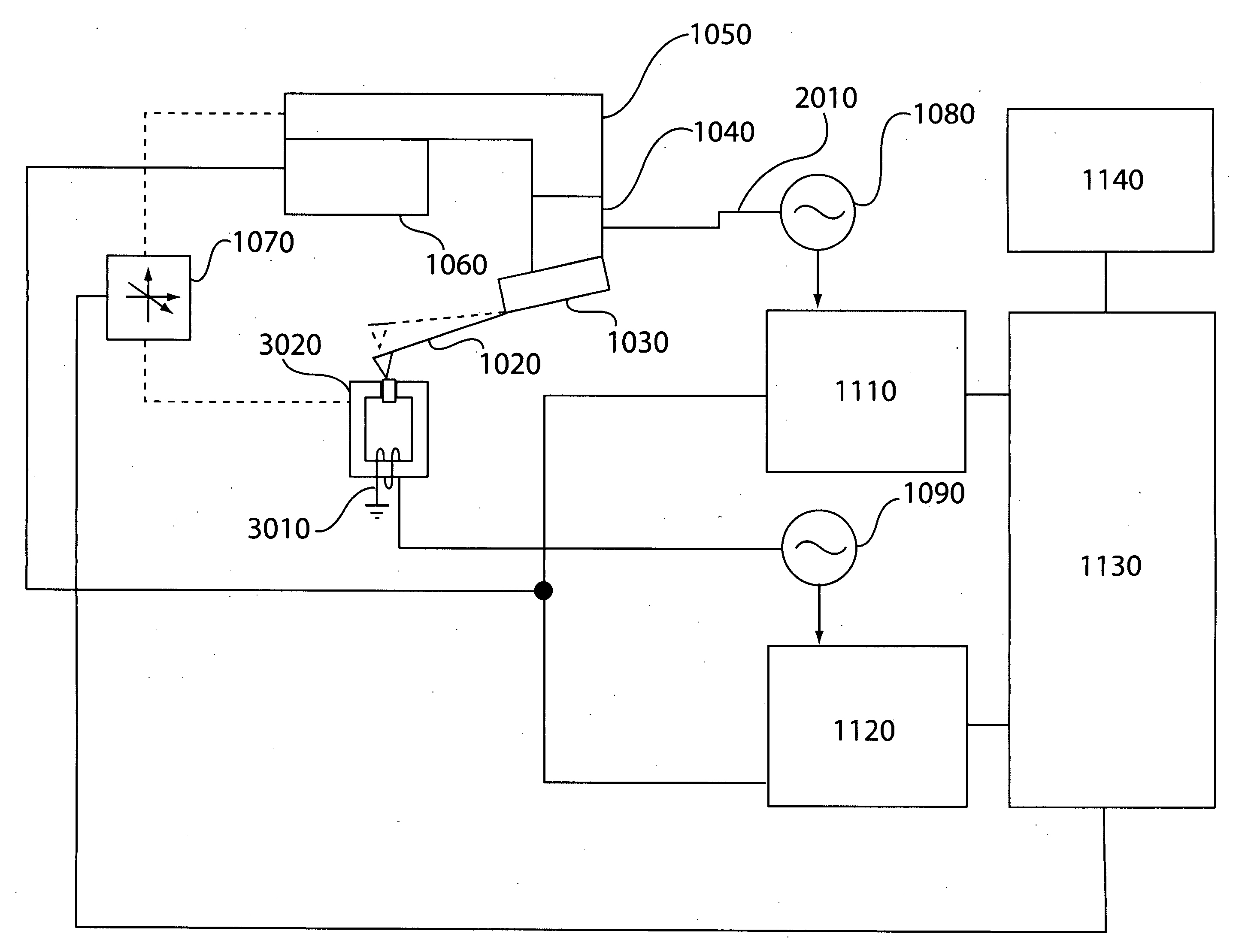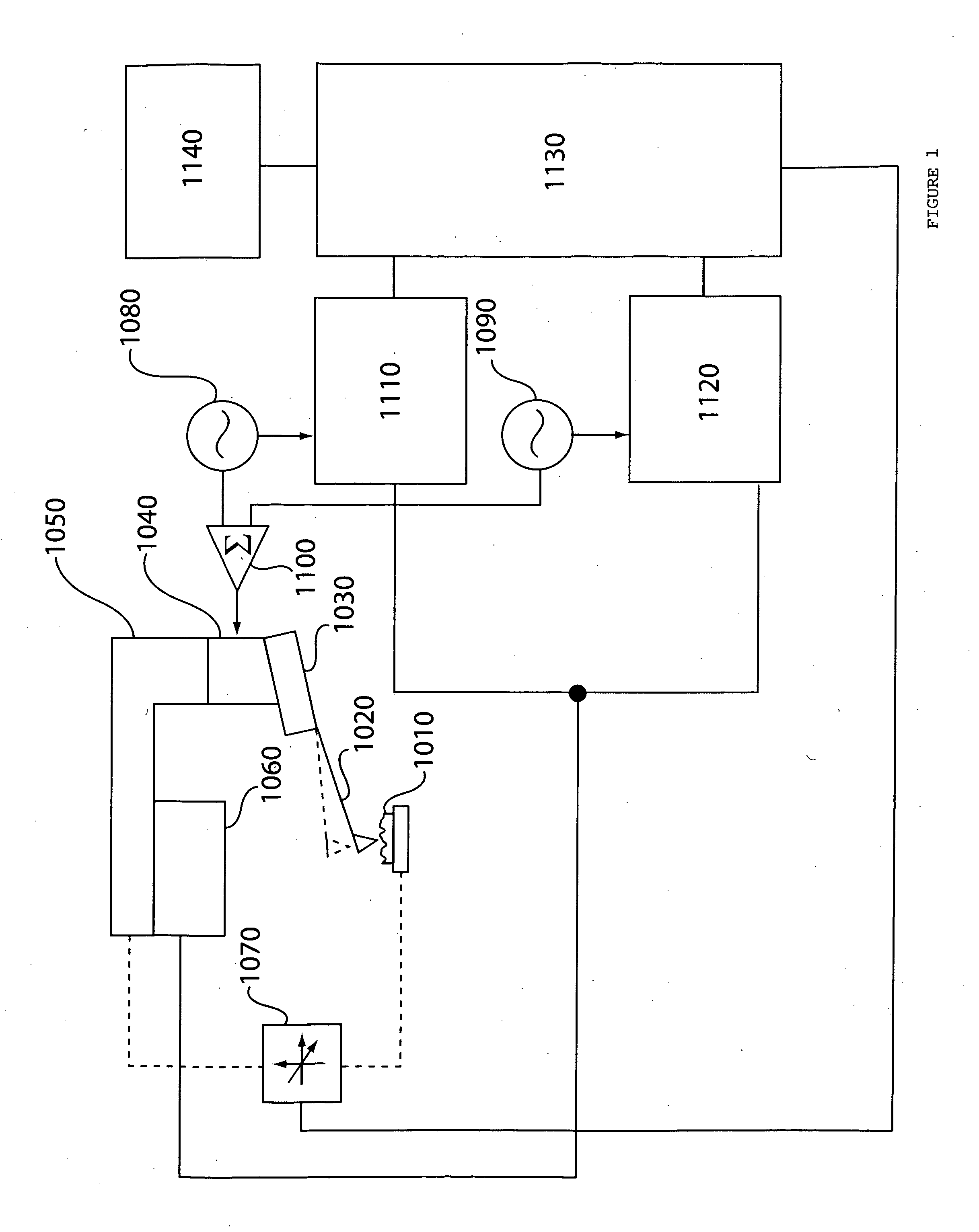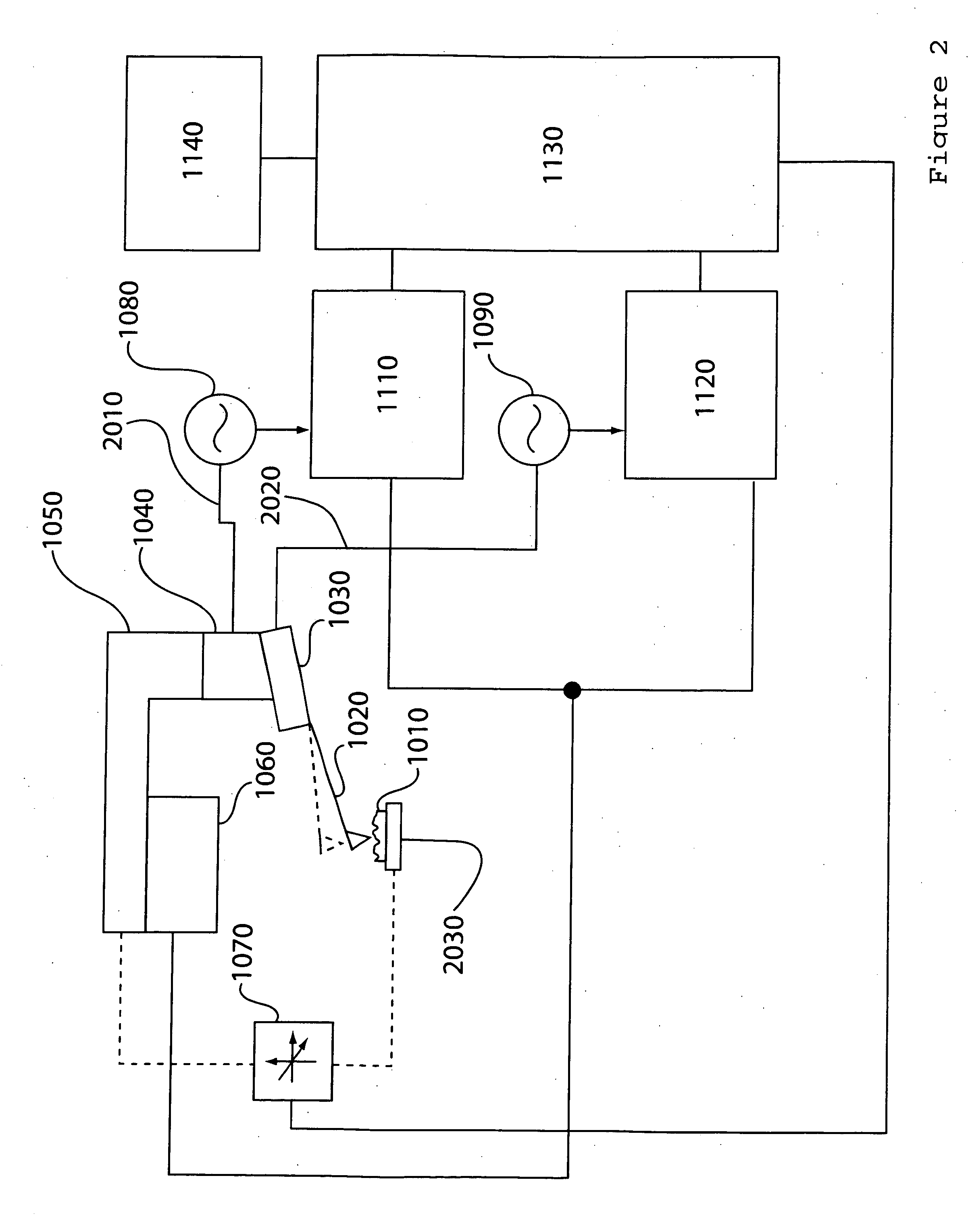[0104]Direct electric driving of the
cantilever (“active cantilevers”) using the present invention has several advantages over conventional piezo force
microscopy where the
cantilever is generally scanned over the sample in
contact mode and the cantilever
voltage is modulated in a manner to excite motion in the sample which in turn causes the cantilever to oscillate.
[0105]FIG. 2 is a
block diagram of a preferred embodiment of an apparatus for using the present invention with an active cantilever. This apparatus has similarities to that shown in FIG. 1, as well as differences. In the FIG. 2 apparatus, like the FIG. 1 apparatus, one frequency source 1080 is used to excite motion of the cantilever probe 1020 through a mechanical
actuator 1040, preferably a piezoelectric
actuator, but other methods to induce cantilever motion known to those versed in the art could also be used, which drives the
chip 1030 of the cantilever probe 1020, However, in the FIG. 2 apparatus, the frequency source 1080 communicates directly 2010 with the
actuator 1040 instead of being summed together with the second frequency source 1090, as in the FIG. 1 apparatus. The second frequency source 1090 in the FIG. 2 apparatus is used to vary the potential of the cantilever probe 1020 which in turn causes the sample 1010 to excite motion in the cantilever probe 1020 at a different eigenmode than that being excited by the first oscillator 1080. The resulting motion of the cantilever probe 1020 interacting with the sample 1010 will contain information on the sample
topography and other properties at the eigenmode excited by the first frequency source 1080 and information regarding the
voltage dependent properties of the sample at the eigenmode excited by the second frequency 1090. The sample holder 2030 can optionally be held at a potential, or at ground to enhance the effect.
[0106]In one method of using the FIG. 2 apparatus, the amplitude of the cantilever at the frequency of the first source 1080 used as the
error signal. The amplitude and phase (or in-phase and quadrature components) at the frequency of the
second source 1090 or a
harmonic thereof will contain information about the motion of the sample and therefore the
voltage dependent properties of the sample. One example of these properties is the piezo-response of the sample.
[0107]FIG. 3 is a
block diagram of a preferred embodiment of an apparatus for using the present invention with the second frequency source modulating a
magnetic field that changes a property of the surface. In the FIG. 3 apparatus, the situation with the first frequency source 1080 is identical to the situation in the FIG. 2 apparatus. Instead of the second frequency source 1090 being used to vary the potential of the cantilever probe 1020 as with the FIG. 2 apparatus, in the FIG. 3 apparatus the second frequency source 1090 modulates the current through an
excitation coil 3010 which in turn modulates the magnetic state of a
magnetic circuit element 3020. This element could be used to modulate the field near an active sample 3030 (not shown) or the
excitation coil 3010 and
magnetic circuit element 3020 could comprise the sample, as in the case of a magnetic
recording head.
[0108]The FIG. 3 apparatus can be used with any other sort of ‘active’ sample where the interaction between the cantilever and the sample can be modulated at or near one or more of the cantilever flexural resonances by one of the frequency sources 1080 or 1090. This could also be extended to
high frequency measurements such as described in Proksch et al., Appl. Phys. Lett., vol. (1999). Instead of the modulation described in that paper, the envelope of the
high frequency carrier could be driven with a
harmonic of one or more flexural resonances. This method of measuring signals other than topographic has the
advantage of requiring only
one pass to complete as opposed to “LiftMode” or
Nap mode that require spatially separated measurements of the topographic and other signals.
[0109]Another example of a preferred embodiment of an apparatus and method for using the present invention is from the field of ultrasonic force
microscopy. In this embodiment, a
high frequency carrier is amplitude modulated and used to either directly drive the sample or to drive it using the cantilever as a
waveguide. The cantilever deflection provides a rectified measure of the sample response at the carrier frequency.
[0110]This embodiment is similar to the conventional force modulation technique where the cantilever is typically operated in
contact mode. As with other
contact mode techniques, however, the force modulation technique has the
disadvantage that the forces acting between the tip and the sample can be quite significant, often resulting in damage to the tip or sample and reduced spatial resolution.
[0111]However, because the ultrasonic force embodiment described here is an AC imaging method, the damage to the tip and / or sample is significantly reduced as compared to contact mode techniques. Thus, one or more eigenmodes are used for the Z-
feedback loop, taking the place of the contact mode
feedback loop, and one or more additional eigenmodes can be used to measure the high frequency properties of the sample.
[0112]The described embodiments of the invention are only considered to be preferred and illustrative of the inventive concept. The scope of the invention is not to be restricted to such embodiments. Various and numerous other arrangements may be devised by one skilled in the art without departing from the spirit and scope of the invention.
 Login to View More
Login to View More  Login to View More
Login to View More 


